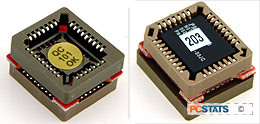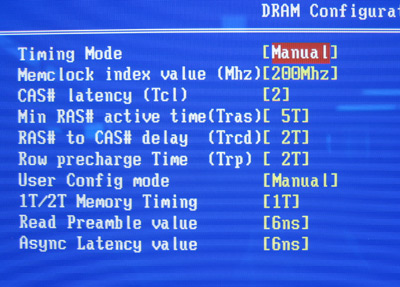 ECS has come up with a
novel way of protecting end users from the experience of a bad BIOS flash. Rather
than mounting two BIOS chips on the motherboard itself, a second is supplied
in a specialized double-sided BIOS socket. ECS call this backup solution the "Top-Hat" flash module.
ECS has come up with a
novel way of protecting end users from the experience of a bad BIOS flash. Rather
than mounting two BIOS chips on the motherboard itself, a second is supplied
in a specialized double-sided BIOS socket. ECS call this backup solution the "Top-Hat" flash module.
Since the surface mounted BIOS ROM contacts
are exposed  on the actual motherboard, the backup ECS "Top-Hat"
flash module can simply clips on top of the board mounted BIOS chip when it is needed.
on the actual motherboard, the backup ECS "Top-Hat"
flash module can simply clips on top of the board mounted BIOS chip when it is needed.
Should there be a bad BIOS flash, the ECS Top-Hat flash module will
take over from the onboard BIOS, and once the board is up and running take off the
Top-Hat device and proceed to re-flash your motherboard. The process is very
simple and it works quite well, just make sure you keep the Top-Hat module in a safe
spot that you will remember!
Overclocking the ECS KN1 Extreme
 |
| Overclocking Results: |
|
|
Overclocking is
traditionally a weak spot for ECS boards, but after seeing the nice voltage options on the
KN1 Extreme we were hoping for better luck at it.
Before we started the overclocking
session, I first lowered the memory clock speed to 166 MHz mode. I
would have decreased the CPU multiplier as well but that option was not available, perhaps
ECS can include this option in future BIOS revisions.
Starting at 200 MHz FSB I raised the motherboard clock speed slowly in ~10 MHz intervals.
Things went by pretty well for the KN1 Extreme until the system hit its
first snag at 217 MHz. Increasing the processor voltage to 1.6V solved the problem
though. Remember, the multiplier is stuck at 12x so when we increase the
motherboard clock speed, the CPU speed also increases.
I continued to increase the frequency and the motherboard eventually maxed out at the 238 MHz mark, anything
higher and the system would BSOD while running 3D benchmarks. Increasing the CPU voltage
or lowering the HTT frequency did not appear to help in any
way, so I left it at that.
Investigating the BIOS Options

ECS gives end users the same memory timing adjustments we would
expect from a high performance motherboard. From CAS Latency, to Row Precharge
and RAS to CAS delay, tweakers should be familiar with the settings here.

The motherboard clock speed can be adjusted from between 200-250
MHz in 1 MHz increments. You can also increase the CPU voltage +0.375V above
stock and increase the DIMM voltage to 3.11V which is quite a bit!
 |
| PCStats Test System Specs: |
| processor: |
amd athlon64 4000+ |
| clock speed: |
12 x 200 mhz = 2.4 ghz |
| motherboards: |
asrock k8 combo-z/asr (ali m1689)*
soltek
sl-k8tpro-939 (k8t800 pro)*
epox 9nda3+ (nf3 ultra)*
albatron
k8x890 pro ii (k8t890)**
gigabyte ga-k8nxp-9 (nf4
ultra)**
epox ep-9npa+ ultra (nf4 ultra)**
msi k8n neo4
platinum (nf4 ultra)**
gigabyte ga-k8nxp-sli (nf4 sli)**
msi
k8n neo4 platinum/sli (nf4 sli)**
dfi lanparty nf4 sli-dr (nf4
sli)**
asus a8n-sli premium (nf4 sli)**
ecs kn1 extreme (nf4 ultra)** |
| videocard: |
asus x800xt/vtd*
msi
rx800xt-vtd256e** |
| memory: |
2x 512mb mushkin pc3200 special ed.
|
| hard drive: |
40gb western digital
special ed
74gb western digital raptor sata |
| cdrom: |
aopen combo 52x |
| powersupply: |
pc power & cooling turbocool
510 sli |
| software setup |
windowsxp
via 4in1 4.55v
forceware
6.53
catalyst 5.4 |
| workstation benchmarks |
sysmark 2004
business winstone 2004
content
creation 2004
super pi
sisoft sandra
2004
pcmark04
3dmark2001se
3dmark05
aquamark3
comanche
4
x2: the threat
ut2003
ut2004
doom 3
| |
pcstats has upgraded its test platform with a
couple of 74gb western digital WD740
Raptor hard drives, replacing the trusty 40GB WD IDE HDDs as test drives.
Please keep that in mind when viewing the office and disk benchmarks.
